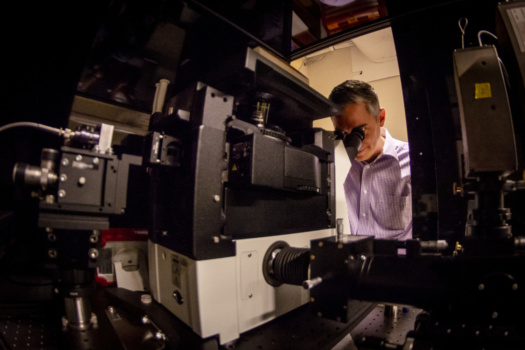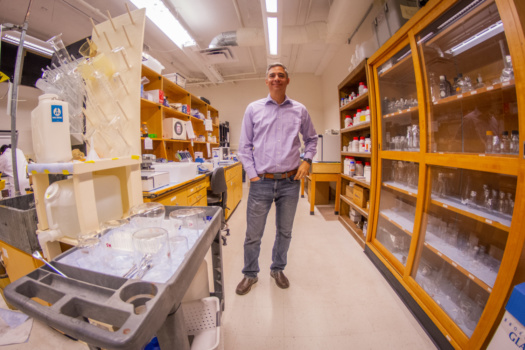Meet a Tiger: Hugo Sanabria, associate professor of physics and astronomy – Clemson Newsstand
Hugo Sanabria looks into the smallest places to find answers to life’s biggest questions.
An associate professor doing research in biophysics, Sanabria joined Clemson’s physics and astronomy department in 2014 and went about designing and building a microscope that could zoom in to a single molecule and measure its movement in time and space.
The result is a shiny black and metal box about the size of a photo booth that sits on thick metal legs containing pneumatic pistons that keep its tabletop perfectly still. It weighs close to a ton and lives in a room on the second floor of the Kinard Laboratory of Physics now called the Single Molecule Biophysics Lab (SMBLab). Inside the box is a microscope connected to a labyrinth of smaller boxes – amplifiers, lasers, and other equipment – that make it powerful enough to watch single molecules at work.
“I have several proud moments, but a big one was actually building this machine,” said Sanabria during an interview in the SMBLab. “From design to conception and having it run – the first time I was able to take measurements here was a eureka moment. It changed everything.”

Hugo Sanabria, assistant professor of biophysics in Clemson University’s Department of Physics and Astronomy, uses the microscope he designed for studying single molecules, in the Kinard Laboratory of Physics, Sept. 17, 2019.
Analyzing the smallest particles through a microscope is akin to studying planets and galaxies through a telescope in a lot of ways, and indeed Sanabria sees his work as an exploration of uncharted worlds; the pieces of which could hold the keys to life. The measurements taken by Sanabria and his team are used to develop targeted drug therapies. For instance, one of his projects is a collaborative research study of a protein that is considered to be a suppressor of cancerous tumors.
“We study individual molecules, the building blocks of life,” said Sanabria. “We look at them individually to understand how they work. It’s like opening the hood of a car and seeing how the motor works. We want to see what they are made of and how they move because how they move represents their function and by understanding function one can correct misfunction.”
Sanabria’s lab is one of the few places in the world that can take those types of measurements, and the scientific community is beginning to take note.
“We’re putting Clemson on the map,” he said. “I think, eventually, as my students graduate, they will take the name of Clemson and it will make an impact wherever they go.”
“Dr. Sanabria is a rising star in his field and his high-impact work is already being recognized by his peers around the world,” said Sean Brittain, chair of the physics and astronomy department. “He is also a caring and conscientious teacher and fantastic colleague. From his efforts to build study abroad opportunities for students in Mexico and Chile to leading the research component of our department strategic plan to providing hands-on engagement opportunities for Clemson students in his lab, Dr. Sanabria drives science forward at our university.”

Hugo Sanabria, assistant professor of biophysics in Clemson University’s Department of Biophysics and Astronomy, stands in one of his labs in the Kinard Labratory of Physics, Sept. 17, 2019. (Photo by Ken Scar)
Sanabria was born in Mexico City. His mother, Graciela, raised him and his brother, Bernardo, while his dad, Manuel, worked as an accountant. Sanabria earned a Bachelor of Science in physics engineering at Tecnológico de Monterrey in Mexico in 1999 and obtained his Master of Science and Ph.D. in physics at the University of Houston in 2002 and 2005, respectively.
He met his wife, Inna Yanez-Orozco, while they were both studying physics and engineering at Teconológico de Monterrey. They later entered the Ph.D. program at Baylor College of Medicine.
“She was pursuing a biomedical Ph.D., which she didn’t finish, but it was her research that sparked my interest in biophysics,” he said, adding that he didn’t have to wait long to pursue that interest. “Monterrey Tech really encourages all its students to study abroad. I did one at Iowa State University, which was extremely cold for me, so I decided if I move to the states I’d go to the South where it’s warm, and here I am!”
In 2018, Sanabria earned one of the National Science Foundation’s most prestigious honors when he was named a recipient of the Faculty Early Career Development (CAREER) award, and this year, he was the recipient of the Board of Trustees award for excellence and the Horiba Young Fluorescence Investigator award– but he is not one to rest on his laurels. He vows to keep growing and getting better in all aspects of his work.
He was recently promoted to associate professor and this year he is participating in the fourth iteration of the President’s Leadership Institute (PLI), which he sees as an important next step in his career.
“The PLI was a real opportunity to strengthen my leadership skills and to get to know people around Clemson and how higher education works in America because so far my perspective has been mostly as a student and recently as a faculty. The PLI is the best opportunity to really get that hands-on experience and find out how to become a leader.”

Hugo Sanabria, assistant professor of biophysics in Clemson University’s Department of Physics and Astronomy, has a laugh in a lab in the Kinard Labratory of Physics, Sept. 17, 2019.
Sanabria’s path to Clemson is unique, but he hopes to make his story less unique during his time here.
“Bringing diversity to campus is one of the things that I am personally pushing for,” he said. “To make more stories like mine, more people like me. Because for that little boy growing up in Mexico this is a dream come true.”
Sanabria says the most rewarding part of his work is engaging and challenging his students — “Just seeing a student’s eyes go wide open when they see the potential of what they’re doing” — and showing them how physics can be a microcosm of life in general.
“Your work is really a part of you and physics is the most elemental science in nature,” he said. “It’s not only that you get to know how the world works – the fundamentals and principals behind it – but it generates problem-solving skills. There are moments when you are studying physics when you have to solve a problem, and you have no idea. Suddenly things will start to click and you realize you can do much more than you think you were capable of. I always tell my students: Try to do what is hard so you know you can accomplish it and much more. That kind of life experience will lead you to your dreams.”





